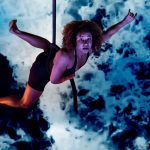On 21 May 2018 XR Circus reached an important milestone: four months on from the first set of workshops our five groups of artist-practitioners presented works-in-progress in the Brighton Spiegeltent. Their exploratory work was made possible by a collaborative research project that brought technologists, practitioners, researchers and industry partners together. Funded by the AHRC and EPSRC research councils, this University of Brighton and Kings College London project was supported by Driftwood 360, Without Walls, Seachange Arts, Freedom Festival Arts Trust and Lighthouse Arts.
This evening of entertainments was the culmination of a series of intensive workshops, creative encounters, collaborations and development activities. A process that exposed our selected artists to the very latest technologies, allowing them to expand their ideas of how new technologies might augment their practice. Importantly, this event put their prototypes and creative experiments in contact with the last vital component: an audience. As audience experience was a major research question that drove the project, the responses gathered as part of this evening will be vital for the future direction of the individual works and research project as a whole.
First up was Vicki Amedume from Upswing Arts who introduced her presentation by discussing the value of the XR Circus project to the company she leads. The work Upswing produce is about telling stories in interesting and creative ways and the technologies they explored as part of the project clearly held future potential. The fragment Vicki and, aerialist, Alfa Marks presented used a projection of water rippling as a backdrop. At the core of this experimentation was a watery audio soundscape that provided a poetic and expressive aural illustration of a rope artist who appeared to swim through water and gasp for breath. Vicki highlighted that the binaural experience was best experienced via headphones, offering the invitation to the audience to enjoy the audio later via headphones and in the private seclusion of a watery environment, such as a bath.
This was followed by Carolyn Watt*, who presented a romanticised version of an aerialist as she climbed silks whilst displaying her body. Rather than being one immaculate body in the live performance space, this representation of an aerialist was disrupted by different perspectives of her body refracted across media: a camera mounted within her glittering feathered headdress replayed her perspective against the screen behind her, whilst this was live-streamed again as video 360 on Facebook. Another iteration presented separately later saw Carolyn provide individuals with their own VR video 360 experience of being ‘her body’ in the air. This rooted them in both the real and virtual worlds through holding the silks she climbed. Both experiences sought to empower audiences by giving them different experiences and insights into an aerialist’s body.
Loved these new perspectives created by @carolynw_circus @owlwink @NickDriftwood @hightopcircus #XRCircus pic.twitter.com/W0RgoMkMRZ
— Donna Close (@donna_close) May 22, 2018
Emma Cat presented her environmentally-driven experience focused on the interaction of insects and plants. Her projection was presented across three screens. The central screen displaying coloured images of plants and insects, with white line representations across the two screens flanked her. Her movements were choreographed against an orchestral score supplemented by the sound of insects such as crickets. Emma later described how this atmospheric soundscape formed her central experimentation and a possible area for development.
#xrcircus Another beautiful piece combining live performance, sound and moving images pic.twitter.com/uSwf6xvNde
— Ewan Kirkland (@EwanKirkland) May 21, 2018
The final performance within the tent was a series of explorations into how a live body could interact with projections and a central object: a white cube. Directed by Rowan Fae of Fulltilt Aerial and performed by Nome Hunter, these took the form of: playing with shadows, live projections fed with a delay to create silhouettes and refracted images of the performer’s movements, dancing with a pre-recorded version of herself and images controlled by the dancer’s movements as picked up by a Kinect. This latter experimentation was rendered as an angular body that, at times, also refracted. The same technology was also used to control geometric patterns through proximity and gesture.
Outside the tent, and throughout the evening, a smaller circus structure plied its wares by entertaining small audiences. Trajectory Theatre, presented one-to-one performances of a special miniature circus whose narrative was driven by Augmented Reality. Enticed into a small white wooden box by a sideshow barker, their circus presented snatches of circus history that required the audience to interact with the team, technology and their structure. Audiences looked, held, pulled and pushed objects within the space using flaps, switches and pulleys to trigger three stories from circus’ fantastic 250 year history.
Circus in a bottle begins! An immersive experience from @ourtrajectory @BSpiegeltent one of our #xrcircus projects! pic.twitter.com/MTYHPy70vg
— Sarah Atkinson (@DrSarahAtkinson) May 21, 2018
Throughout the evening each individual artist or group spoke about their XR Circus experience. They described a process of learning and development that suggested XR Circus had provided new experiences and tools, whether that was new technology or an introduction to another performance medium. Yet, at the same time as this was exciting for our artists, they also highlighted the frustrations of bumping against the limits of their technical understanding or of viable technologies.
It will be interesting to observe how this XR Circus experience expands the coordinates of our artists’ practice…
Great to be part of the Live Lab of #XRCircus, funded by @ahrcpress as part of the Immersive Experiences call. Great demonstration of how creative performance can be enhanced by digital technology. pic.twitter.com/uLKOa9edBa
— Paul Meller (@paulmeller29) May 21, 2018
* Carolyn Watt’s PhD is part funded by the Interreg 5A France (Channel) England Research project PONToon, June 2017-November 2020, led by the University of Portsmouth, CCI
If you want up to the minute on every development from XR Circus then make sure you follow @XRCircus and keep an eye on #XRCircus where we live tweet workshops and events.



